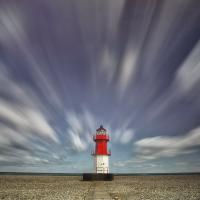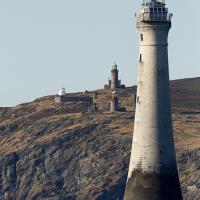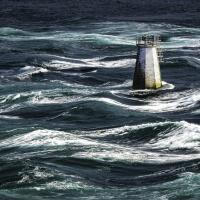The IOM Photographic Societys meeting was again cancelled this week due to the Covid-19 lockdown still continuing, However, it has provided the perfect opportunity to explore and enjoy some of the delights of the Manx countryside as we move into Spring and to investigate and learn of the history and origins of whatever is our subject.
Being an island, it will be no surprise that lighthouses are a prominent feature of our landscape, with a total of ten, though only six are still operational, four having been de-commissioned, though their buildings remain. The inactive ones include the Winkie at the Point of Ayre (inactive since 2010) plus the three on the Calf of Man (two inactive since 1875 and the third since 2007, and all replaced by the Chicken Rock lighthouse which has been in operation since 1875).
The six operational lighthouses have been the responsibility of the Northern Lighthouse Board (NLB) since 1815, four counting as main lights (Douglas Head, Point of Ayre, Maughold and the Chicken Rock) whilst Langness and the Thousla Rock (in the Sound, between the mainland and the Calf as seen in the image by Barry Murphy) count as minor lights. All are checked and maintained annually by the Northern Light Vessel NLV Pharos, all being fully automatic, the last to be converted being Langness in 1996.
The first lighthouses on the island were two on the Calf (the upper and lower in the attached image by Tony Curtis, taken from the far side of the Chicken Rock seen in the foreground). These date from 1815, and were designed by Robert Stevenson, grandfather of the novelist Robert Louis Stevenson. Amongst his many engineering skills, Stevenson proved to be a master at lighthouse design, being responsible also for the Point of Ayre lighthouse. This was built in 1818 and is now the oldest of our operational lighthouses, still retaining its original fresnel lens from 1890, and giving it a range of more than twenty miles. The smaller Winkie lighthouse, also at the Point of Ayre, was built in 1888 as a back-up to the main light, but was de-commissioned by the NLB in 2010. Ayre is derived from norse language and means gravel bank - and obvious from the image by Jeremy Broome-Smith shown here. Stevensons design business was passed in dynastic style to his two sons David and Thomas who were responsible for the lighthouses at Chicken Rock, Douglas Head and Langness, whilst grandson Charles took on Maughold Head.
Interestingly, every light is different, the pattern of light each emits varying in duration to ensure a unique signature so there can be no mistake for shipping in identifying the light.
I must also differentiate between lighthouses and harbour lights the latter being numerous and all the responsibility of IOM Harbours, part of the Department of Infrastructure. The island has eight harbours, each with navigation lights to assist shipping access varying from one to four lights, usually placed on the breakwaters or piers as appropriate. Again, the pattern of light and the colours vary to ensure safety for navigation, and as with the lighthouses, must be able to withstand severe storm impact.
Given the Covid-19 situation, our programme is currently in abeyance and we are unable to provide a date for our next meeting, so please check our website www.iomps.com or our Facebook page for details of any updates or changes. Our meetings are held the St John Ambulance HQ on Glencrutchery Road, starting at 7:00 pm and are open to the public (non-members with a modest entry fee), and all will be given a very warm welcome.
The Isle of Man Photographic Society is supported by the Arts Council
Chris Blyth
CAPTIONS:
IMAGE 01: Winkie Lighthouse by Jeremy Broome-Smith
IMAGE 02: Calf Lighthouses by Tony Curtis
IMAGE 03: Thousla Rock by Barry Murphy



